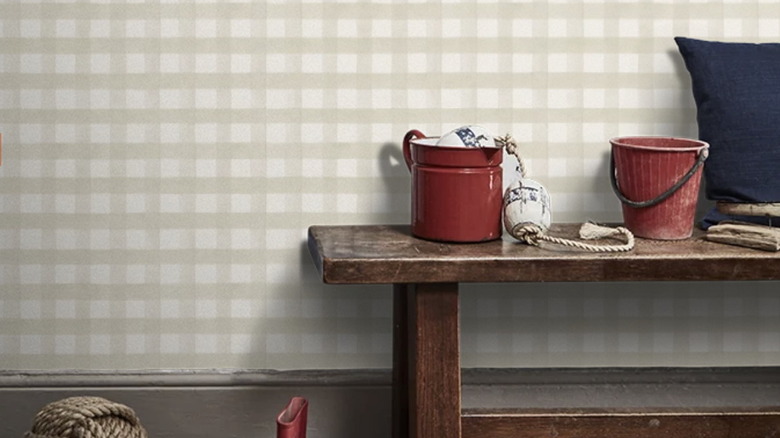Gingham Makes The Cutest Accent Wall Pattern - And It's Easy To DIY
Gingham is often associated with summer and picnics. This simple checked pattern is a sure-fire way to make any space classic yet adorable, and it can be added to your home in a wide variety of ways. You may be familiar with gingham in fabric home décor items such as sheets, blankets, pillows, furniture upholstery, and curtains, but you can also incorporate gingham design in bolder, more unique ways. Once you figure out how and where to use checkerboard patterns in your home décor, you can make stunning creative choices like adding gingham to your walls as an accent. There are some wallpaper options, but to get a look tailored to your exact wants and potentially save some money, you can also easily DIY the cutest gingham accent wall by painting the pattern.
To paint a gingham feature wall yourself, you will need paint, painter's tape, a paint roller, a level, and a pencil. For the paint, two to four colors are necessary to get the right effect. First, decide what your base color will be. A shade of white or off-white is a classic choice for gingham. If your wall is already painted, you can use it as a base color, but you might also want to purchase your base color paint to add a fresh coat anyway. For best results, find two colors of different saturation from the same family. Shades of red, blue, green, or yellow create a lovely, bright wall, while shades of brown or gray make for a more calming, subtle accent.
How to paint a gingham pattern on a wall
The optional first step is to apply your base coat of paint to either refresh the paint or change the color. Once your base coat is dry, use your level and pencil to sketch the lines for your gingham print. Start with the vertical lines, using the level to ensure that they are equally spaced and straight. Then, pencil in the horizontal lines, continuing to use the level for equal spacing and straight lines. Lines that are closer together will create a smaller checked pattern, while further apart lines will result in larger squares. Both can look stylish, but keep in mind that smaller squares will require a lot of time and patience.
Now that your pattern is mapped out, carefully tape your vertical lines and use your paint roller to apply two coats of the light shade of your gingham color paint for the vertical stripes between the lines. After the paint dries, you can remove the vertical tapes and apply the horizontal ones along the pencil lines. Again, use a clean paint roller to apply two coats between the lines, covering the vertical stripes as well. If you have two shades of your gingham color, use the lighter shade again. If you have three shades, use the slightly darker shade, not the darkest one. Finally, on the squares where the horizontal and vertical paint lines intersect, tape around the square and paint the square using two coats of your darkest shade.
Is this DIY worth a try?
The end result of a gingham accent wall is absolutely gorgeous, but there are some points to consider before attempting this project. This DIY is very time-consuming. You will be waiting for six layers of paint to dry throughout the process. Add that to the time spent measuring and drawing the lines on the wall, taping, and painting, and you will figure out that this DIY is no small feat. Additionally, depending on the paint you buy and the number of shades you use, the total price of the project can add up, as a gallon of paint can cost between $20 and $70. It seems worth comparing your estimated painting cost with the estimated cost of purchasing and putting up gingham wallpaper. Plus, choosing not to paint does not rob you of a DIY opportunity; you can use these five simple tips for wallpapering your home like a professional.
Gingham is a perfect way to add some cottage or farmhouse charm to your home. It can work in any space from the kitchen or bathroom to a bedroom or hallway. Select the right colors, and you can find yourself in a calming, nostalgic room or a bright and trendy one. Whether you choose to take on the easy but long DIY process of painting or the potentially more expensive but shorter process of applying wallpaper, be sure to follow tips for perfectly styling gingham. This will ensure the rest of your home matches your lovely new wall design.

